how to get rid of a spider bite
Spider mites are tiny pests that can infest houseplants and outdoor plants. These plant pests look like tiny spiders and they can do a lot of damage to plants. The first sign of spider mites is their tiny webs on the plant. Other signs of spider mite damage include black or brown spots on the plant leaves.
Spider mites belong to the mite family Tetranychidae and they are a type of arachnid, not a kind of insect.
Many species of spider mites are tiny white creatures. But other types of spider mites can have red, green, brown, or yellow color.
Spider mites look like tiny bugs but they are difficult to spot. They usually live under leaves where they spin white, silky webs for protection.
The most common sign of a spider mite infestation is spider webbing. But if the plant is severely infested, spider mite damage can also include black or brown spots on plant leaves. If you suspect that spider mites are causing plant damage, put a piece of white paper under the leaves and gently shake the plant. Spider mites will look like specks of ground pepper.
This article is a comprehensive guide to getting rid of spider mites on plants. As well as natural spider mite treatments, you'll find out about ways to control spider mites and prevent them from infesting your houseplants.
What Do Spider Mites Look Like?
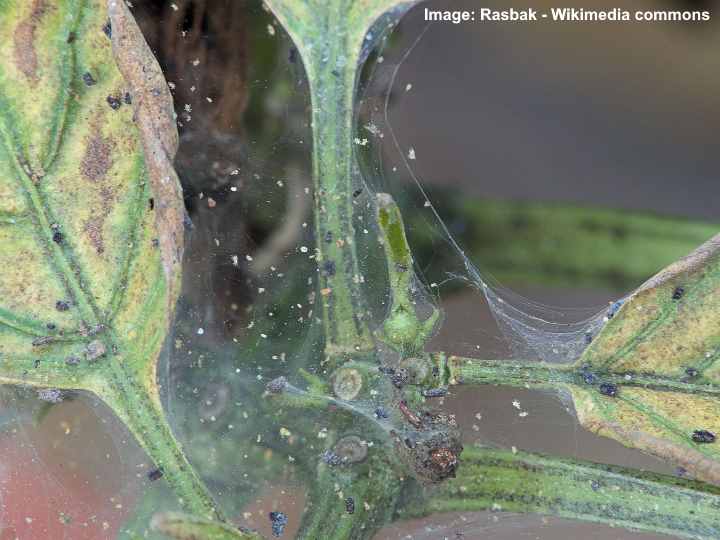
This picture shows spider mite damage on sweet pepper plants – the spider mites are the tiny white bugs on the sticky webs.
Spider mites look like minuscule white, red, tan, or black spiders. Spider mites are only about 1 mm long, so noticing them on plants is challenging. You probably see the telltale spider mite sign—webbing—before spotting the mites. You might only notice these tiny "bugs" if an infestation is large.
Looking at pictures of spider mites, you'll see the tiny bugs have oval-shaped bodies. The tiny "bugs" have eight legs because they are a type of spider or arachnid, but they don't look like typical spiders. They spin webs just like spiders, which is the first clue to looking closely for them on plants.
If you have a few spider mites on houseplants, you probably won't see the web-spinning mites. They are generally no larger than the period at the end of sentences. If you've got a significant infestation, the mites look like tiny dots scurrying about under leaves.
Spider Mites Life Cycle
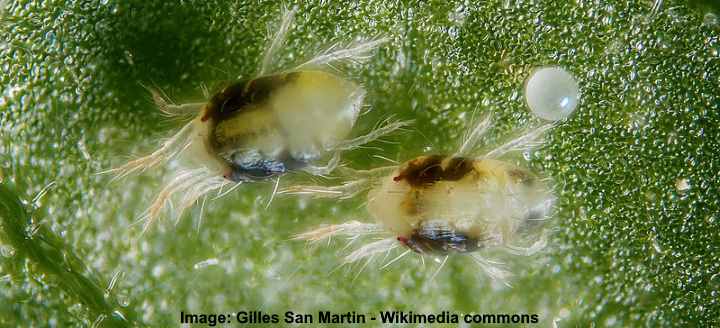
Two-spotted spider mite females with spider mite egg
The life cycle of spider mites starts as a tiny egg before turning into larvae and then becoming an adult. It takes between five and twenty days for spider mites to reach maturity and complete their life cycle. An adult spider mite can live for four weeks. Female spider mite can produce hundreds of eggs during its life.
Spider mites thrive and reproduce rapidly in hot, dry conditions. Within a matter of days, a female can grow to adulthood and start laying up to 20 eggs a day. In a bad spider mite plant infestation, there can be multiple generations overlapping.
Spider mites generally don't live in potting soil. They prefer the underside of leaves where they can go undetected for weeks. However, keeping the soil slightly humid can help control spider mites as they like dry conditions.
Use the best houseplant watering methods to keep the soil slightly moist, but not overly damp or soggy—otherwise, you'll get more problems.
How to Identify Spider Mites on Houseplants and Outdoor Plants
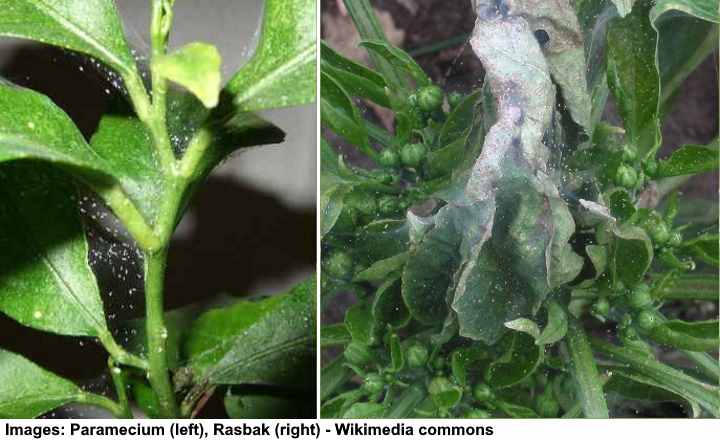
Spider mite damage on a lemon plant (left). Spider mite damage on sweet pepper plant (right). You can also see the spider mite webs on the plant leaves.
The easiest way to identify spider mites that infest plants is by their webbing. Spider mites produce thin webs to protect themselves and their young. Look for webs under leaves and at leaf joints. When infestations get out of control, you will see many tiny dot-like creatures crawling below the webs.
To help identify spider mite infestation, look for delicate strands of silk-like threads. At the start of an outbreak, you will only see a few web-like threads dangling from leaves. However, you probably won't be able to see any spider mites. As their activity intensifies, you will see more extensive areas of webbing and tiny white bugs on the webs.
Plant damage is another way to identify spider mites. Spider mites use their piercing mouth-parts to bite into plant tissue. You could identify spider mites if leaves become bleached, discolored, or yellow. When the damage caused by spider mites is so severe, you'll probably see numerous of tiny white or brown dots under leaves.
For accurate spider mite identification, you'll need a 10x hand lens. Looking closely at the moving dots should reveal an oval-shaped body with eight tiny legs. Spider mite eggs are identified as being round and transparent. At the first sign of plant webbing, it's crucial to identify spider mites to get rid of the plant bugs.
Tapping the leaves is another way to identify spider mites. Put a piece of white paper under plant leaves. Tap the leaves to see if tiny spider mites fall on to the paper. If you've got spider mites, you'll see the little "bugs" drop and look like ground pepper.
Spider Mite Plant Damage
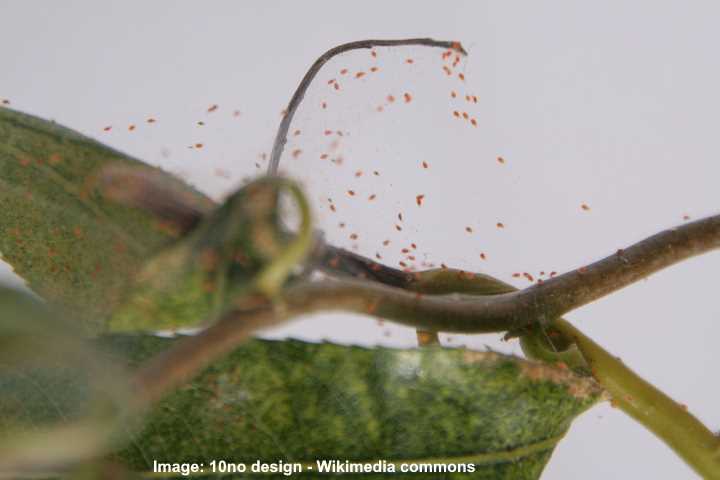
Spider mites cause leaf damage to the plant and in severe infestation can cause the plant to die. This picture shows tiny red spider mites on webs with leaf discoloration
Spider mites can cause extensive damage to houseplants and outdoor plants. Apart from covering leaves in silky spider webs, their sap-sucking feeding damages leaves. First, brown or yellow blotches appear on damaged leaves, which eventually lose their color. If left uncontrolled, spider mite damage can result in the plant's death.
Spider mite leaf damage—Tiny spots on leaves are the first telltale sign of spider mite damage. As the damage becomes worse, the dots can make an almost solid pattern—called stippling. In time, plant leaves can start to yellow, curl, and then fall off.
Spider mite damage on crops—Spider mites are also very destructive on outdoor plants and vegetables. A massive mite infestation can destroy crop leaves, leading to a lower yield. You can also notice spider mite leaf damage such as leaf spotting on roses, annual plants, legumes, soybeans, and sugar peas.
While not damaging to plants, spider mite webbing creates a protective environment for these pests to thrive.
Where Do Spider Mites Come From?
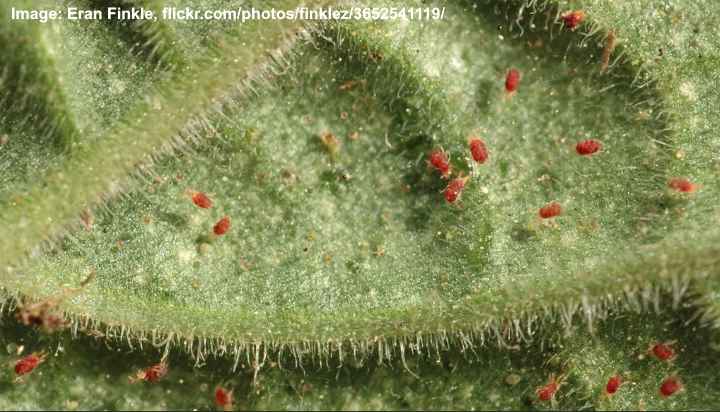
Red spider mites on a leaf underside
Unfortunately, spider mites are so tiny, and they can come from anywhere. The most common source of spider mites is bringing new plants into the home that are infested. However, spider mites can also come from unsterile potting soil, or get blown onto houseplants that are outside in summer.
Spider mites can also come into your home on your clothes—especially if you're just back from the local garden center. Or, spider mites can hitch a ride into your home on pets. However, the most common way that mites get into your house is on contaminated plants.
How to Get Rid of Spider Mites on Plants
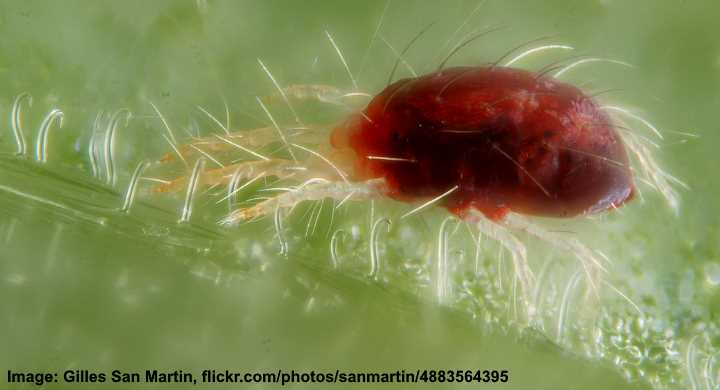
A female red spider mite (enlarged image)
Before taking the first steps to get rid of spider mites on your plant, remove the plant and isolate it.
It's best not to use pesticides to get rid of spider mites. Resistance to synthetic chemicals is common, and pesticides are rarely effective.
If it's not a good idea to use commercial pesticides, what can you use to eradicate the pesky plant-destroying pests? Thankfully, there are plenty of natural, non-toxic remedies to kill spider mites.
When battling a spider mite infestation on plants, the first step is always to isolate the affected plant. Removing the plant from other plants prevents the spider mite problem from spreading to more plants.
Prune Affected Leaves to Get Rid of Spider Mites
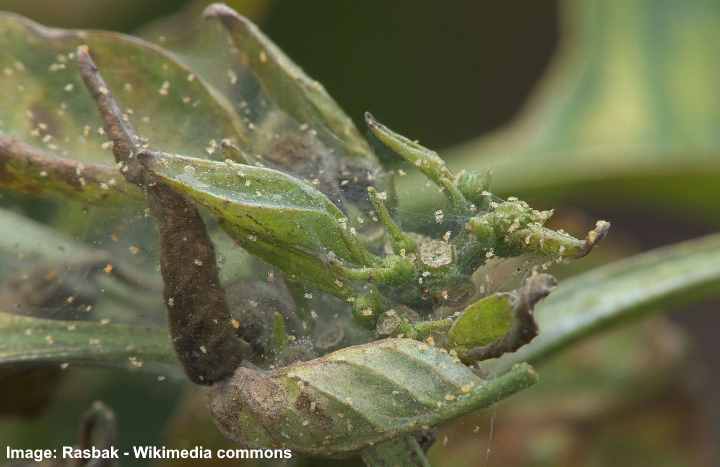
Remove and discard affected parts of the plant to prevent damage to other plants
Prune affected plant leaves and stems that show signs of silk-like webbing to remove the spider mites naturally. Discard the infested plant parts in the trash outside your home to prevent contaminating other plants in your home or yard.
After pruning the affected leaves and stems, it's still a good idea to treat the rest of the plant with natural spider mite control methods. These could involve hosing the plant with water, treating with neem oil, applying rubbing alcohol, or wiping leaves down with insecticide soap.
Shower Plants to Remove Spider Mites
Hose off spider mites and remove unsightly spider webs by using your bathroom shower. The force of water should dislodge the annoying mites. You can also turn the hose on outdoor plants using a strong jet of water to get spider mites off your plants.
Use Soap Spray to Kill Spider Mites on Plants

Spray insecticidal soap solution on the spider mites to kill them. You can also wipe the plant leaves with a sponge dipped in the soap solution to control spider mites.
Get rid of spider mites from plants with soap such as Castile soap or other liquid dish soap. Mix 1 teaspoon of soap with 1 quart (1 l) of lukewarm water and shake well. Use the spider mite spray liberally on the plant leaves until all the mites are gone.
You could dip a sponge in the soap solution and wipe down the plant to remove and kill spider mites. Reapply as needed until all signs of the mites are gone for good.
The soap works on contact to eliminate populations of plant spider mites. The soapy liquid coats their bodies and suffocates the little bugs, mites, or insects. The fatty acids in the soap also penetrate the pests and cause them to dehydrate and die. These insecticidal soaps are safe to use around children and pets and are suitable for organic gardening methods.
You can also use soap to kill other houseplant pests such as aphids, thrips, mealybugs, scale insects, and whitefly.
Get Rid of Spider Mites on Plants with Neem Oil

Neem oil is an effective way to get rid of spider mites on plants
Neem oil is a natural solution for controlling all kinds of houseplant pests, including spider mites. Neem oil is also useful for spider mite prevention. Make a spider mite spray solution by mixing neem oil, a little Castile soap, and water. Spray on the infested plant leaves.
The neem oil recipe for a natural, organic spider mite spray is two teaspoons neem oil, one teaspoon Castile soap mixed with 1 quart (1 l) lukewarm water. To kill the tiny mites, spray liberally under leaves, on stems, and anywhere else you notice signs of spider mites.
Neem oil is a popular natural pesticide because it doesn't harm birds, worms, humans, or pets. The reason why neem oil can help kill spider mites is that it disrupts the hormones of pesky houseplant pests.
Read our complete guide to using neem oil on plants (including neem oil spray recipe).
Apple Cider Vinegar Spray to Get Rid of Spider Mites on Houseplants
Control spider mites with an apple cider vinegar (ACV) natural spray. Using white vinegar if fine too. Vinegar is highly acidic, which plant pests such as spider mites hate.
Make a spider mite spray by mixing 1/4 cup vinegar, 1 tablespoon baking soda and a few drops of liquid dish soap in 1 quart (1 l) of lukewarm water. Spray wherever you see evidence of spider mite activity until they are completely gone.
Rosemary Oil Spray to Eliminate Spider Mites From Indoor Plants
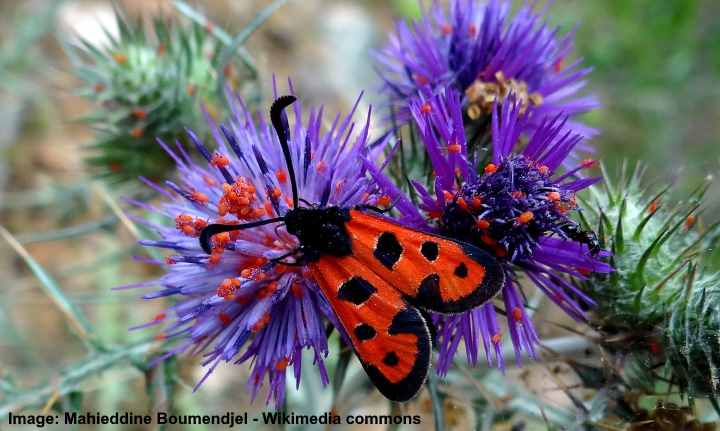
In the picture: red spider mites and a butterfly on a plant
Rosemary extracts have a natural insecticidal activity that may be useful for controlling spider mites. Dilute a teaspoon of rosemary oil in 1 quart (1 l) water and fill a spray bottle to treat a spider mite infestation. Rosemary oil pest control is non-toxic for humans and pets but can be lethal on spider mites.
According to one scientific study, a commercial rosemary oil treatment was effective in killing off two-spotted spider mites on tomato plants. The natural product was safe to use on edible plants without any risk of toxicity. (1)
You may need some trial and error if you make your own rosemary spider mite spray at home. It can be tricky to get the right concentration of rosemary oil to cause spider mite mortality.
Use Rubbing Alcohol to Kill Spider Mites on Plants
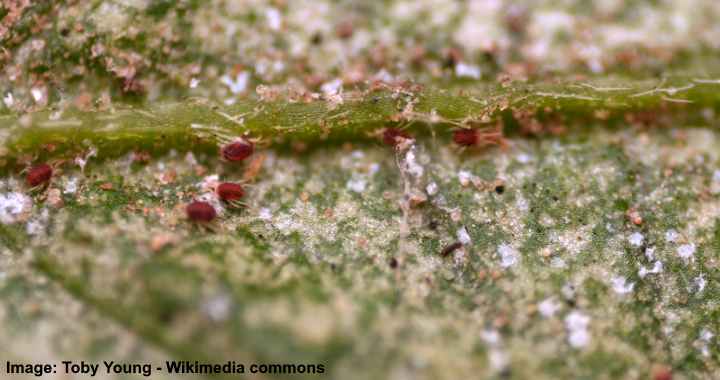
This image shows red spider mites on a leaf underside
Rubbing alcohol effectively kills spider mites on contact. Just put some 70% isopropyl alcohol on a clean cloth and wipe the underside of the affected plant leaves. Alternatively, you can mix one-part rubbing alcohol with one-part water and kill the spider mites that are infesting your plant.
Some houseplants have sensitive, delicate leaves. So, if you notice that leaves show signs of burn, try diluting the alcohol spray solution to a 1:3 alcohol to water ratio.
You can also use rubbing alcohol to kill off other indoor plant pests such as mealybugs, whitefly, and aphids.
Release Beneficial Insects To kill Spider Mites on Outdoor Plants
Use ladybugs, predatory mites, or lacewing to control outbreaks of spider mites in your garden. Beneficial insects feed on insect-like arachnids and can help to reduce their numbers significantly. You can use predatory mites in addition to other spider mite eradication methods.
How to Prevent Spider Mites on Plants
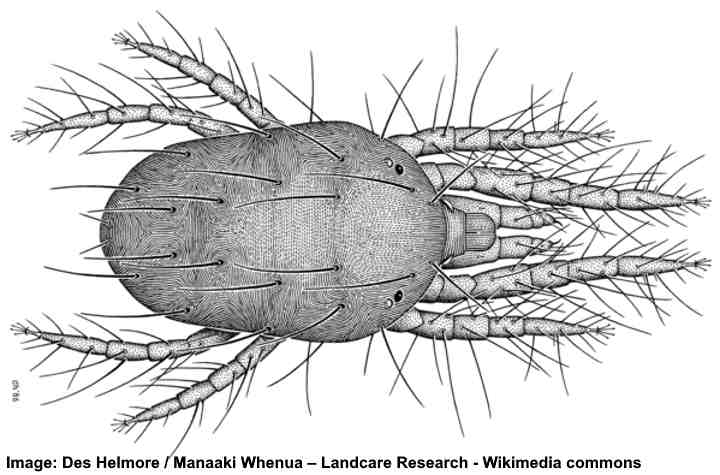
Spider mite illustration
The best way to prevent spider mites is to inspect all plants before bringing them into your house. Also, high room humidity and regularly wiping leaves create an environment that prevents spider mites from thriving on houseplants. With regular houseplant care and vigilance, you can avoid spider mite infestations.
Keep humidity high to prevent spider mites on houseplants
High humidity deters spider mite from setting up home on your houseplants. Regularly mist plant leaves, sit indoor plants on pebble and water trays or use a humidifier to prevent spider mites. Also, don't let houseplant soil dry out, but regularly water it to keep it slightly moist.
Thoroughly check new houseplants
Prevent spider mites from getting into your home by thoroughly checking new plants. Closely look for signs of spider mite activity such as silky webs, brown leaf spots, or tiny dots on the underside of leaves.
Do you like to keep houseplants outside during the summer? Make sure and debug them before bringing them back inside. The last thing you want to do is bring spider mites into your house to infest other indoor plants.
Wipe plant leaves regularly
Wiping houseplant leaves with a damp cloth helps keep spider mites away due to two reasons. First, wiping leaves with a wet cloth humidifies leaves. Second, regular plant leave wiping removes tiny mites before they get the chance to do any plant damage.
Related articles:
- Common Houseplant Pests: Types and Identification
- How to Get Rid of Gnats on Houseplants
- How to Get Rid Of Aphids on Houseplants
Read Next
how to get rid of a spider bite
Source: https://leafyplace.com/spider-mites/
Posted by: dickinsondifusest.blogspot.com

0 Response to "how to get rid of a spider bite"
Post a Comment